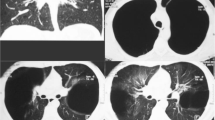Abstract
Five patients of primary lung cancer with giant bullous diesase underwent surgery from April 1985 to December 1995. All patients were male and heavy smokers, and the median age was 50 years. The location of the tumor was in the right upper lobe in four patients and in the left upper lobe in the other. Three patients were treated by lobectomy and two by sleeve lobectomy. Histological examination showed large cell carcinoma in four patients and poorly-differentiated adenocarcinoma in the other. The pathological stage was I in three. IIIA in one, and IV in the other. Two of three in stage I have survived for more than 6 years postopertively without recurrence, and the other died of brain metastasis. The stage IIIA case and the IV case died 3 years and one year postoperatively, respectively. The clinical features of lung cancer associated with giant bullous disease was discussed by reviewing 33 patients reported in Japan, including our patients. In 13 patients, lung cancer and bullous disease were diagnosed simultaneously (group A), and in 20 patients, bullous disease were diagnosed prior to the appearance of an abnormal shadow due to lung cancer (group B). The patients in group B had a tendency to be diagnosed at an earlier stage of lung cancer than the patients in group A. In the patients of stage I, the 5-year survival rate was 78.6%, however, in the patients of more than stage IIIA, 3-year survival rate was 26.5% and the 5-year survival rate was 0%. Significant differences in the survival curves were demonstrated between the cases with stage I and the cases with more than stage IIIA. In conclusion, in order to improve the prognosis of lung cancer with giant bullous disease, it is considered to be important to detect giant bulla prior to lung cancer, and when a case of bullous disease is found, periodical follow-up must be done to find early stage lung cancer.
Similar content being viewed by others
References
Stoloff IL, Kanofsky P, Magilner L: The risk of lung cancer in males with bullous disease of the lung. Arch Environ Health 22: 163–167, 1971
Goldstein MJ, Snider GL, Liberson M, Poske RM: Bronchogenic carcinoma and giant bullous disease. Am Rev Resp Dis 97: 1062–1070, 1968
Homa MY: X 33: 206–211, 1974
16: 906–912, 1978
3 34: 710–714, 1981
9: 486–492, 1995
39: 1585–1588, 1984
39: 381–386, 1985
34: 392–394, 1981
Giant bulla 41: 69–73, 1982
occult lung cancer 41: 832–835, 1982
22: 481–486, 1982
Giant bulla 22: 719–723, 1984
24: 203–208, 1984
32: 89–94, 1986
46: 1051–1055, 1987
27: 189–193, 1987
Giant bulla 49: 1409–1417, 1988
26: 766–769, 1988
Bulla 52: 527–530, 1990
46: 814–817, 1993
Korol E: The correlation of carcinoma and congenital cystic emphysema of the lungs. Report of ten cases. Dis Chest 23: 403–411, 1953
1983, p5
Author information
Authors and Affiliations
Rights and permissions
About this article
Cite this article
Sato, S., Asakura, J., Suzuki, H. et al. Study on surgical treatment for lung cancer associated with giant bullous disease. Jpn J Thorac Caridovasc Surg 46, 260–266 (1998). https://doi.org/10.1007/BF03217740
Received:
Accepted:
Issue Date:
DOI: https://doi.org/10.1007/BF03217740




